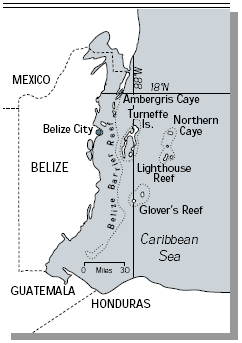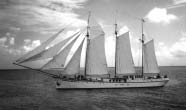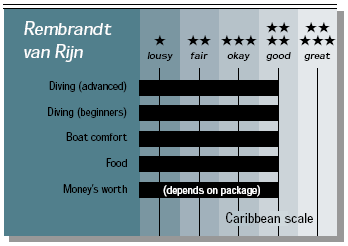Off Belize on the Rembrandt van RijnContents of this Issue: Off Belize on the Rembrandt van Rijn Attention Shoppers: Air Fare Bargain Who’s Selling Sekonic Meters for How Much? Editorial Office: Ben Davison Publisher and Editor Undercurrent 3020 Bridgeway, Suite 102 Sausalito, CA 94965 Sailing and diving with the Dutch masters from the February, 1997 issue of Undercurrent
Dear Fellow Diver, Imagine plying the seas aboard a classic and stately, centuryold, 184-foot, three-masted schooner, its main deck replete with pulleys and sheets and furled canvas. Hear the mainsail snap as it catches the warm winds of the trades. Then kick back and relax as you silently glide to your next dive site. That's how I spent a July week in Belize -- and believe me, after diving these reefs aboard both the Aggressor and the Wave Dancer, this was an experience unto itself. Wilder and woolier than most Caribbean diving, the second largest barrier reef in the world has always been among my fondest Caribbean dive destinations. While other Belize live-aboards congregate north along Lighthouse Reef and use common moorings, the Dutch-flagged Rembrandt van Rijn covers the three major atolls seaward of the barrier reef -- Turneffe Islands, Northern Caye, and Glover's Reef to the south. By diving from inflatable dinghies, we weren't limited to the overdived environs of fixed moorings. The boat driver put us right on the best spots and on any others that we cared to explore, followed our bubbles, and expertly picked us up when and where we surfaced. A few dives, especially at night, we made from the mother ship. A Trip on a Sailing Ship A nonstop on Continental from Houston to Belize City introduced me to a small reception committee at the airport from the Rembrandt. After that it was a boring, three-hour wait at a funky dockside cafe/bar for the ferry trip out to the ship. Rebuilt from the hull up in 1993, the Rembrandt began as a herring lugger, a classic sailing ship, at the turn of the century. She's now comfortably outfitted and air conditioned to please diver and nondiver alike.
She's not as elegant as a Carnival cruise ship, but housing and feeding 20 divers and crew in a 184-foot hull puts her a step up from most live-aboards. My small cabin below decks had its own shower and head (as do all), twin upper and lower bunks, storage space, and a bright reading light. In the main deck lounge, several people can belly up to the bar to schmooze with the bartender or relax at tables. There's a TV set and a VCR, but I preferred the after-dinner night dives, conversations, and relaxing on the main deck under the stars. The library features sea-life ID books, worn novels, and some works on the boat's great artist namesake. Next door is the dining room, where all meals are served at one long table and several smaller ones. The forward deck, partly covered by an awning, has lounge chairs and tables for hanging out between dives. The dive area and operation differ from the sterling Hughes and Aggressor fleets. Though I had plenty of room to kit up, the dive area was cluttered with tanks, oil drums, a mast, and sails. I stored my gear in the roomy, built-in bench bin and hung my Lycras (July water 84° , winter as low as 76° ) from the ubiquitous riggings. The tanks were huge, European 92-cubic-footers filled to 3,200 psi; although I had no problem hooking up my regulator, one diver found that his didn't fit, so the crew replaced the first-stage yoke. We had to remove BCs and regulators for fillings, a minor inconvenience. With smiles, the Filipino-Belizean crew shuttled the tanks to and from the inflatables alongside the ship. It was a hefty step from the big boat into the little boats. To dive, one entered the water with a back roll. For the strenuous exit, we handed up our tanks to the crew and gave a hearty kick.
Tuna, Tarpon, and Turtles Our first stop was at Majestic Point, off Turneffe Atoll, where my initial dive augured well for the remainder of the trip. Immediately on entry I frolicked with a large turtle, then pursued a large, free-swimming green moray. The spur-and-groove formations and tunnels led to a sheer wall rising from the depths. Above patches of black coral swam schools of chromis, lots of parrotfish, packs of patrolling jacks, and swarms of snappers, grunts, groupers, and wrasses. On the second dive, at Myrtle's Turtle, I spent time up close with four dolphins. A turtle (Myrtle or otherwise) rested under a coral head. Tuna, mackerel, and tarpon swam off the wall and several scorpion fish lurked in the recesses of the reef. At night, under a brilliant full moon, we saw crabs galore, some decorated, some reef crabs, and small ones hiding in the corals. A fine end to my first day. Dives at Lighthouse Reef and Glover's Reef were a mixture of drift dives off the wall and easy prowls through spur-and-groove formations. The visibility on most dives ran about 60 feet. At Half Moon Caye a gregarious dolphin spent several hours trying to seduce one of our grey inflatables. With mask, fins, and snorkel I had great fun swimming with her, but the policy was "Look, don't touch." At the Cathedral Wall I saw a pair of spotted eagle rays, big groupers, and barracuda, while on the reef I spotted indigo hamlets and, in the sand, yellowhead jawfish. I saw nurse sharks on a few dives, and one day a lonesome remora attached itself to a diver during his safety stop. Everywhere were plenty of Paul Humann's featured tropicals and a proliferation of large and colorful sponges, for which Belize -- and especially Glover's Reef -- is unrivaled in the Caribbean. At night, I thrilled at the large silver tarpons gathering under the boat lights. I saw several rare batfish in the sand and scores of spotted trunkfish on several sites.
No matter how pleasant the diving, if the food isn't up to snuff, the trip fails. Rembrandt meals, prepared with a European accent, surely passed muster -- business class, not first class -- with such ample dinner entrées as spare ribs, chicken kebabs, and beef stew, full breakfasts (between 8 and 9 a.m.), and lunches of cold cuts, soups, chicken, and spaghetti. I try to follow a non-meat, low-fat diet and had a time getting it squared away with the Jamaican chef, but he was cooperative and we struck an accord. The dinners (served at 7:30) were pleasant meals, filled with the conviviality of the passengers, who included a Dutch rock star, his comely fiancée and her comely sister, an ex-fighter pilot from Atlanta, and a tailor who fits the Dutch royal family with clothing and uniforms. After dinner, the captain explained the next day's plans. While I dived, nondivers took the second dinghy for excursions to the booby bird sanctuary on Half Moon Caye or to the Manta resort on Glover's Reef for a cold Belikin and a snorkel in the lagoon. Oh, and don't forget the famous Blue Hole at Lighthouse Reef. The Rembrandt anchored well off, leaving a 20-minute run through the reef for the inflatables. Although for me it had become a "been there, done that, got the T-shirt" dive, I still enjoyed sinking 130 feet into the deep blue, peering at the stalactites, and watching my computer tell me this was one short dive indeed. But I burned enough energy to enjoy the iced tea, fruit, and store-bought cookies awaiting me on the dive deck when I returned. Flies in the Ointment In July, the dive operation was not at peak efficiency. Each compressor broke down for a short period. The smaller boat, a 40-hp inflatable, was slow with a full load, and problems with the 90-hp outboard motor in the larger inflatable were annoying. I've seen these irritations on other boats; they come with the territory. Although the compressor maintenance problem caused some worry mid-week, the engineer got the main one working, and we dodged that bullet without missing a dive. In fact, the entire crew was a picture of efficiency. The purser worked his butt off day and night, the alternating captains -- both named Frank -- were congenial hosts. They tried to arrange two morning dives, an afternoon dive, and a night dive, but it didn't always work because of weather or tight schedule; we averaged slightly more than three a day. Though the Rembrandt generally moves under engine power, we set sail a couple of times, and it was magnificent. Tips on the Dutch Masters The Rembrandt is the first of a planned fleet of reconstructed sailing ships with scuba capability. Her sister ship, originally aimed at the Chagos Archipelago in the Indian Ocean, plies the cold waters off Spitsbergen. Should you book this ship, take a close look at the cabin schematic on the brochure. The forward cabins (1-6) are small and have single bunks top and bottom (during one rough crossing, some people in these cabins complained about the motion). The aft cabins (7-16) are a bit larger, with a double bed on bottom and single on top (no one here complained of undue motion). Cabins 16 and 17 are larger but closer to the engine room. For a couple, Cabin 7, 9, or 11 might be the best choice. The best cabin by far is the Owner's Cabin on the main deck. Towels, soap, and shampoo were plentiful, and bed linen was changed once during the week. Another tip: Although the boat can carry 30 passengers for nondiving cruises, max is 20 on dive trips, so if you're a single traveler on a dive trip, don't pay an extra single supplement. I negotiated with Rima Deeb, the booking agent, and was able to reduce the rack rate considerably. Give it a go; the boat has a reputation for discounting, especially if not fully booked. Also, if you want three dives a day, ask her to make sure it happens. If too many nondivers are on the cruise, they may try to accommodate them and cut a dive or two; but they're fine people, and they'll work hard to meet your needs. I think the only people who will be displeased with this craft are the liveaboard addicts, especially photographers, who want more than three dives. For these folks, I recommend Peter Hughes's Wave Dancer or the Belize Aggressor. For photo buffs, the Rembrandt is not well set up (no light tables, no camera rinse tanks, no E-6 processing). But for divers who cultivate a romantic view of sea travel and can be charmed by a three-masted class act, the Rembrandt will do just fine. E. E. |

I want to get all the stories! Tell me how I can become an Undercurrent Online Member and get online access to all the articles of Undercurrent as well as thousands of first hand reports on dive operations world-wide
| Home | Online Members Area | My Account |
Login
|
Join
|
| Travel Index |
Dive Resort & Liveaboard Reviews
|
Featured Reports
|
Recent
Issues
|
Back Issues
|
|
Dive Gear
Index
|
Health/Safety Index
|
Environment & Misc.
Index
|
Seasonal Planner
|
Blogs
|
Free Articles
|
Book Picks
|
News
|
|
Special Offers
|
RSS
|
FAQ
|
About Us
|
Contact Us
|
Links
|
3020 Bridgeway, Ste 102, Sausalito, Ca 94965
All rights reserved.


 The master of the dive operation, a young Belizean named
Bart, tried hard at first to control the diving, briefing us
only with "Keep the reef on your right, and for this dive do
40 minutes at 40 feet." We divers quickly learned to smile and
assure him we understood. Then we dived our computers to our
heart's content, even solo, without reprimand. A nice young
man, he tried hard to please; nevertheless, he (or the operation)
needs to recognize that computer diving is in
and square, navy-table dives are out. He could use
a blackboard for more informative briefings and
give more thought on how to organize the groups for
each inflatable.
The master of the dive operation, a young Belizean named
Bart, tried hard at first to control the diving, briefing us
only with "Keep the reef on your right, and for this dive do
40 minutes at 40 feet." We divers quickly learned to smile and
assure him we understood. Then we dived our computers to our
heart's content, even solo, without reprimand. A nice young
man, he tried hard to please; nevertheless, he (or the operation)
needs to recognize that computer diving is in
and square, navy-table dives are out. He could use
a blackboard for more informative briefings and
give more thought on how to organize the groups for
each inflatable.  Good Food, Boon Companions
Good Food, Boon Companions